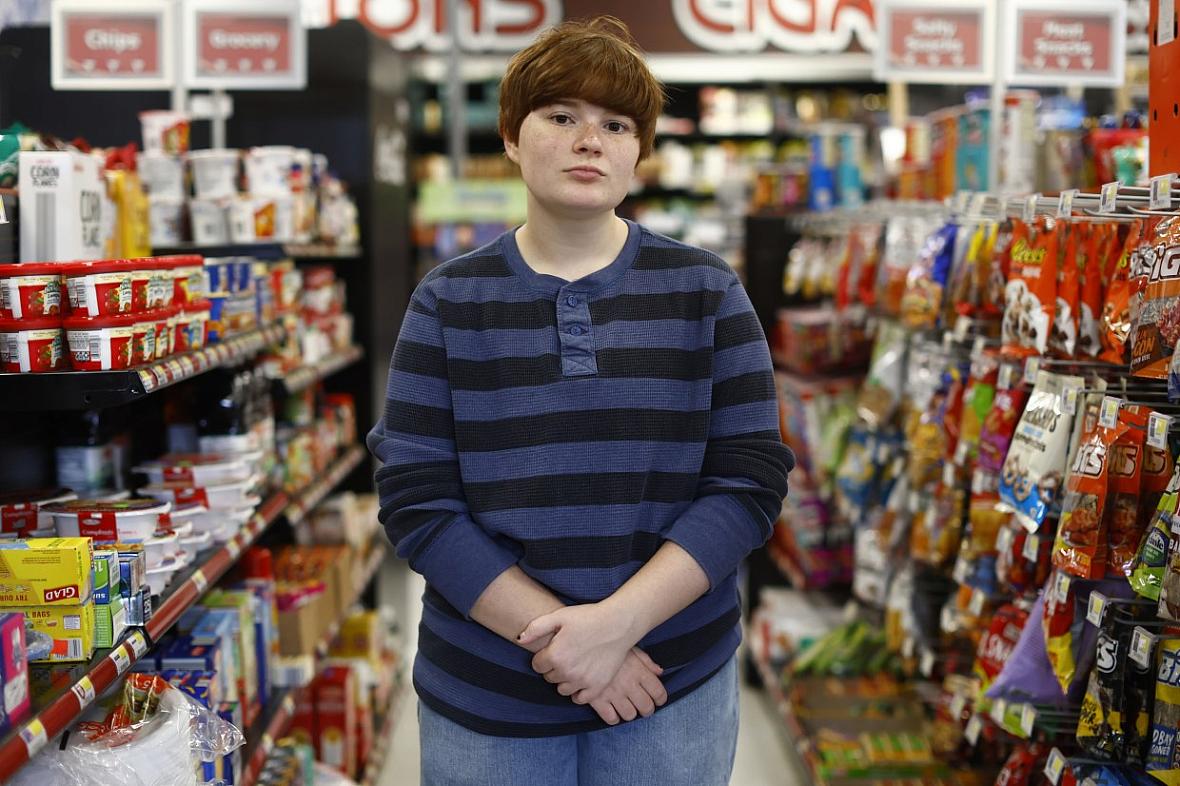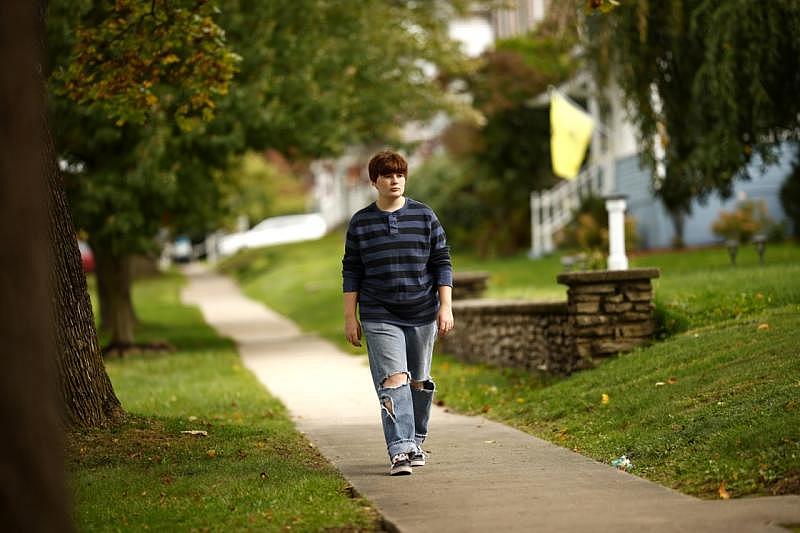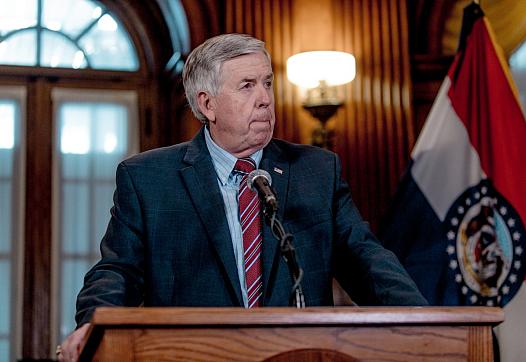School lunch is too costly for a growing number of families. Will a White House pledge help?
The story was originally published in NBC News with support from the USC Annenberg Center for Health Journalism's 2022 National Fellowship.

High school senior Marshall Troese of Clarion, Pa., has a hard time justifying the $2.55 price of a school lunch, because he knows his family’s budget is tight. Sometimes he skips lunch and buys a small bag of chips after school, instead.
Jared Wickerham for NBC News
The end of universal free school meals has left a growing number of families in a financial quandary: unable to keep up with school lunch payments, yet unable to qualify for free or reduced-price meals.
A flood of families have applied for a price break now that school meals cost money for the first time since the early days of the pandemic, and sky-high prices of other essentials constrict parents’ budgets. Many families are within $100 of the modest limit for qualifying for free or reduced-price meals, according to school nutrition directors.
“I’ve cried with a lot of families,” said Angie Richey, nutrition services supervisor of Roseville Area Schools in Minnesota. “I had to tell one family of six that they were $33 over.”
A dozen school nutrition directors — from districts large and small, urban and rural, wealthy and low-income — told NBC News they have had to reject applications from a mother whose insulin price rose significantly; a father who lost his job during the pandemic and has found only part-time work since; and a mother of five whose only income is disability payments because she has cancer, among others.
The Biden administration last week announced a years-long goal of making universal school meals permanent. But it still requires the approval of a divided Congress, and advocates are pushing for immediate action.
The White House strategy starts by expanding access to free meals to 9 million children by 2032. While anti-hunger experts lauded the proposal, they also said many families could not wait for help.
“These changes toward expanding access to all students need to happen as soon as possible,” said Lori Adkins, president of the School Nutrition Association, a trade organization representing 50,000 school nutrition employees. “Some kids are coming to school with no food from home and no money.”
Discussions about the cost of lunch are now commonplace in school cafeterias, said Anji Branch, child nutrition director at Gooding School District in Idaho, who also leads the Idaho School Nutrition Association.
“I’ve never had as many students say, ‘Oh, I can’t eat, I don’t have money,’” Branch said, adding that students still receive lunch even if they cannot pay. “As children, they shouldn’t have to be bothered by that.”
In Clarion, Pennsylvania, high school senior Marshall Troese has a hard time justifying the $2.55 price of a school lunch because he knows his family’s budget is tight. Their car broke down before they found out school would be charging for meals again, and Marshall, 17, said he sometimes skips lunch so he isn’t adding to the burden.
“There’s a point where you get used to being hungry,” he said. On days that he doesn’t eat lunch, he uses change he finds around his house and purchases a small bag of chips from a nearby gas station convenience store after school instead.

On days Marshall Troese doesn’t eat lunch, he uses change he finds around his house and heads to a gas station convenience store for a snack after school, instead.Jared Wickerham for NBC News
He tries to ignore his hunger at school on those days.
“I will be honest,” Marshall said, “Sometimes it does get a bit distracting in class.”
Who qualifies for free lunch now?
With universal school meals over as of June, the threshold for qualifying for discounted meals has now returned to pre-pandemic rules in most of the country: at or below 130% of the federal poverty level and between 130% and 185% of the federal poverty level for reduced-price meals. This school year, a family of four earning $36,075 or less is eligible for free meals, and a family of four earning $51,338 or less is eligible for reduced-price meals.
The price of school meals varies across the country. According to the Agriculture Department’s most recent data available, which is from the 2016-2017 school year, school lunch costs an average of $2.57.
For a family with two kids, that would mean lunch would cost $5.14 a day, or $925.20 for a 180-day school year. For a family with an income of $52,000, it becomes a significant expense — especially given that Moody’s Analytics has found that the cost of basic necessities is up $460 per month compared with a year ago.
Many had expected meals to be free for another school year, but Congress did not extend the waiver, with Republicans reportedly opposed because of the approximately $11 billion price tag.
Nonetheless, a majority of Americans are in favor of universal school meals: 63% of voters support legislation that would make free school meals permanently available to all students, according to the anti-hunger group Food Research & Action Center.
Those in favor acknowledge that it requires hefty funding but say it should be a priority.
“Our kids getting fed should not be political,” said Billie Veach, nutrition director at Adel DeSoto Minburn Community School District in Iowa and the School Nutrition Association of Iowa president.
Stopgap measures for those who cannot pay
If students cannot pay for school lunch, that doesn’t mean they are denied food.
In recent years, most districts eliminated “lunch-shaming” policies and feed children the same meal as everyone else, then contact their parents to alert them to unpaid meal balances. The kindness comes at a cost: Some districts have seen their meal debt balloon.
Heather Plain, child nutrition director at Bonneville Joint School District No. 93 in Idaho, said her district incurred more than $6,000 in meal debt within the first week of school. Part of the problem was not everyone knew school meals cost money again. The district has received 3,200 applications so far for free and reduced-price meals among its more than 13,000 students.
Plain said she found it frustrating to need to do paperwork again after two years of being able to serve free meals without it.
“It really becomes exclusionary,” she said.
Getting families to fill out paperwork is not always easy. Many are busy and some worry about sharing private information, said Krista Hamilton-Neal, nutrition services director of Stillwater Public Schools in Oklahoma.
“My great fear is that somebody is not applying because it is going to cause a problem with their citizenship status,” she said, even though immigration status does not affect eligibility and applicants cannot be deported based on the form.
For Haleyville City Schools in Alabama, where the number of students who qualify for free and reduced meals is 71%, meal debt hovers around $75, said Emma Anne Hallman, child nutrition director and president-elect of the Alabama School Nutrition Association. This is in large part thanks to donors in the community who volunteer to pay off meal debt — something that often happens in other districts too, but that is not sustainable or scalable.
“They ride the bus for free. They get their books for free. Let’s just feed our kids. We’ve proven that we can do it.”
— HEATHER PLAIN, CHILD NUTRITION DIRECTOR
All 12 nutrition directors who spoke to NBC News said the ideal solution would be bringing universal school meals back immediately.
“They ride the bus for free. They get their books for free,” Plain said. “Let’s just feed our kids. We’ve proven that we can do it.”
With universal meals over on the federal level, states step in
While most places have returned to paid meals, five states continue to offer universal school meals. Others offer free breakfast for all students.
Jennifer, a New Hampshire mom of a fourth grader who asked to be identified by first name only to protect her child’s privacy, said she wishes her state was among those that had taken action. On disability because she can no longer work due to an autoimmune condition, she was shocked to see that her disability payments plus child support from her recent divorce disqualified her daughter for free or reduced-price lunch.
Her daughter prefers school lunch, but it’s more cost-effective to pack a lunch from home, which is typically a sunflower butter and jelly sandwich, applesauce and a Go-Gurt yogurt tube.
While anti-hunger advocates say their goal is securing nationwide universal school meals, they have proposed compromises. One is raising the threshold for who qualifies for free and reduced-price meals nationwide, a change that could be especially helpful for applicants in places with a higher cost of living, something that application does not take into account.

Marshall Troese tries to ignore his hunger when he skips lunch. “Sometimes it does get a bit distracting in class,” he said. Jared Wickerham for NBC News
Another is eliminating the reduced-price category so kids receive a free meal instead — something that was proposed for this school year but ultimately cut from legislation that extended other child nutrition waivers.
Sen. Rand Paul, R-Ky., pushed for the return of the reduced-price category. A spokesperson for Paul said in an email, “Spending money we don’t have causes inflation that disproportionately hurts low-income families.”
“I’ve shed more tears this year than I have in my 24 years of food service.”
LORI DANELLA, DIRECTOR OF NUTRITION SERVICES
Families are already hurting, especially if they are on the cusp of qualifying, said Lori Danella, director of nutrition services for Lee’s Summit R-7 School District in Missouri.
“I wish there was some way to help when those families just don’t quite make it,” she said. “I’ve shed more tears this year than I have in my 24 years of food service.”


